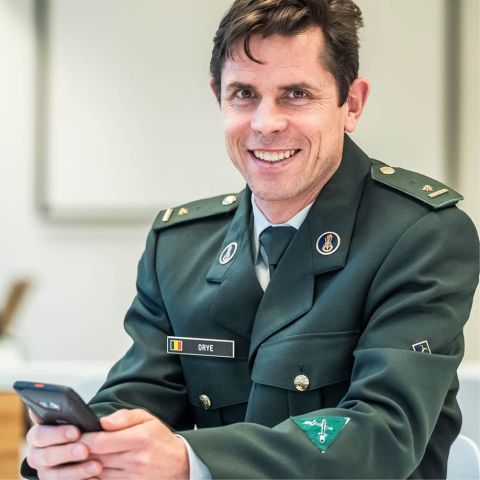Testimonials Ministry of Defence tests secure voice calls via 5G
With the support of the FPS Economy, SMEs, Self-Employed and Energy.

Name
Ministry of Defence
Sector
Security and defence
How 5G is used?
Mission-critical communication networks on domestic military bases
What 5G has to offer
Latency, security
For communication at military bases, the Ministry of Defence uses TETRA (Terrestrial Trunked Radio), a European digital standard for radio communication. The TETRA network offers the advantage of connecting voice calls in less than half a second and, as a private network, it is not overloaded by civilian calls in emergency situations. Despite the many security measures within TETRA, there was room for improvement. When the FPS Economy, SMEs, Self-Employed and Energy issued a call for innovative 5G trial projects, the Ministry of Defence saw this as an opportunity to optimise its communication network.
The ministry approached a number of industrial partners. “From the initial discussions, it was clear that Orange Belgium’s offer was in line with the ministry’s ambitions,” says Major Erwin Orye, Innovation Officer at the Ministry of Defence. “Orange Belgium immediately adopted a proactive attitude and was highly motivated to contribute to this innovation project.” The parties joined forces and the federal government signed off on the joint subsidy application for a proof of concept.
Focus on security
With this project, the ministry wants to determine whether 5G offers the same communication possibilities on military bases as the TETRA network, but with a higher level of security. Major Orye, who is coordinating the project for Defence, explains: “TETRA is known for its reliable operation, so a 5G-based alternative must meet the same strict criteria. But the 5G network supports stricter security measures and we would like to put them to the test.”
Olivier Chamberland, IoT/M2M Customer Project Leader at Orange Belgium, who is responsible for the integration of 5G in the project with the ministry, underscores that focus on security. “Some of the 5G core equipment, the User Plane Function, is installed on the military air force base in Beauvechain, in Walloon-Brabant. This local installation means internal discussions cannot leave the military base.”
Orange Belgium immediately adopted a proactive attitude and was highly motivated to contribute to the project. Major Erwin Orye, Innovation Officer at the Ministry of Defence
Extensive test phase
At the start of the project, Orange Belgium opted to install all the network equipment in its own data centre in Brussels, with an application server for the push-to-talk function of the two-way radios. “The advantage of this approach is that the test phase could be implemented not far from our office and the Ministry of Defence, enabling us to monitor the process closely and intervene instantly in case of problems,” Chamberland explains. “Meanwhile, we have been able to test calls and the test phase has been concluded.”
In the second phase, the entire installation will be relocated to the Beauvechain air force base, where the ministry has its TETRA knowledge centre. According to Major Orye this installation in two phases has been prepared down to the smallest detail: in Beauvechain, all tests will be repeated, first on the radio frequencies of Orange Belgium and subsequently on the military frequencies.
Chamberland emphasises that this is a challenging project. “Because part of the 5G core equipment is not on our premises, we don’t want to leave anything to chance,” he says. “The implementation of a hybrid architecture is a first for Orange and will serve as a blueprint for subsequent projects. Following the test assembly at our 5G Lab in Antwerp, relocating part of our core network is a key technical challenge that requires numerous checks and extensive testing.”
From better security to more options
Orange Belgium’s security specialists designed an architecture that meets the Ministry of Defence’s strict requirements. If, during second-phase testing, there are no issues with calls over the air force base’s 5G network, specialists from the Royal Military Academy will be tasked with performing a security assessment. “In this phase, security is tested extensively in various scenarios,” says Chamberland. “Both the installation and the standard 5G encryption will receive an additional encryption layer as an added security.”
5G will also give the ministry access to a data network with high bandwidth, which was not the case with the TETRA network. The transition to 5G may eventually pave the way for new applications such as bodycams to quickly transmit images in case of emergency. “If our current proof of concept for push-to-talk is successful, the ministry can examine which additional functionalities are useful and whether it can be done with 5G,” Major Orye concludes.
Knowledge transfer
For Major Orye, Orange Belgium’s willingness to share knowledge throughout the process provided significant added value. “Orange Belgium has retrained our engineers who maintain the TETRA network,” he says. “They took a course on the basics of 5G and the security aspects involved, such as network slicing. Whenever we hit technical challenges, Orange Belgium was always very open to helping us solve them. At no time did we get the sense they were giving us a sales pitch. In the end, it truly was a joint research project.”
Are you looking for a suitable environment to test the possibilities of 5G for your business? Or would you like to talk to our experts about what 5G can do for your company? Discover all the possibilities of 5G standalone.
The Ministry of Defence is responsible for protecting Belgium and its citizens. At national and international level, it plays a key role in crisis situations and humanitarian missions.




